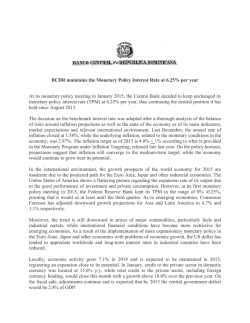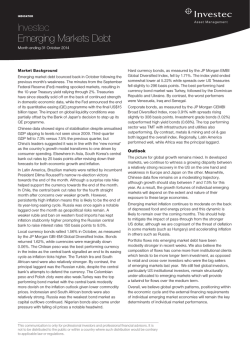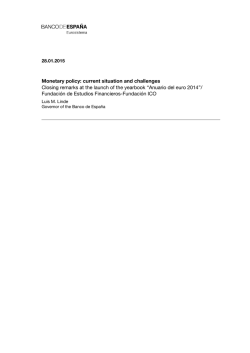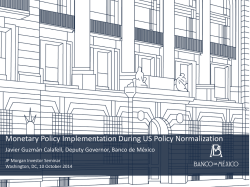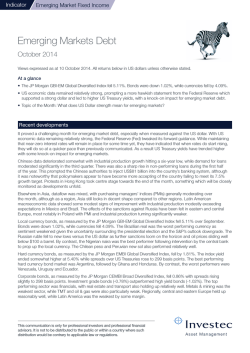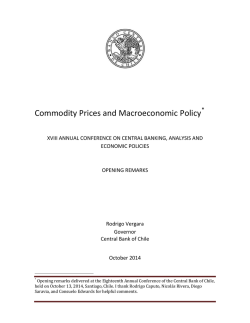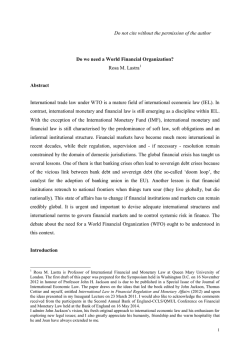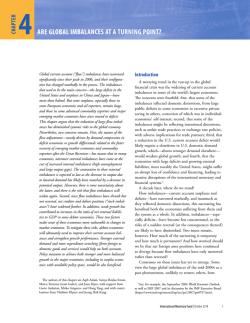
Emerging Markets amid Heightened Uncertainty Remarks by
Emerging Markets amid Heightened Uncertainty Remarks by Manuel Sánchez Deputy Governor The Bank of Mexico at the Crédit Agricole Central Bank Seminar Rome, Italy October 23, 2014 I am honored to join you here today in the magnificent city of Rome, a cradle of Western civilization, one of Europe’s great cultural centers, and a muse for poets and artists throughout the centuries. Thank you for the invitation to share a few words with you on the topic of emerging markets. Emerging economies now confront a new reality, one in which some apparent certainties have disappeared, and different challenges have arisen. I would like to touch on three subjects in this context, starting with the performance of emerging economies, moving on to financial market conditions, and concluding with a brief overview of Mexico in particular. As always, my views are entirely my own and do not necessarily reflect those of the Bank of Mexico or its Governing Board. Developments and the outlook for emerging economies Two distinctive trends characterize developments in emerging economies during the last few years. The first is higher growth since the beginning of this century, relative to the previous decade. Economic expansion has surpassed that of developed nations substantially, with China and India playing prominent roles. What forces have driven this phenomenon? Although emerging economies are not all alike, as a group they seem to have benefited from generally sound policies implemented in the 1980s and 1990s. These include the strengthening of macroeconomic and financial frameworks and the liberalization of markets, 1 reduced regulations, and greater openness to international trade. Additionally, high and rising commodity prices and ample access to external credit during the 2000s have helped. By and large, better policy and institutional settings seem to be responsible for the fact that emerging economies were relatively resilient to the shocks of the Great Recession. Indeed, in 2009, while the advanced economies contracted more than 3 percent, the emerging economies grew slightly above 1 percent. 1 Nonetheless, since 2011, growth in emerging economies has been declining, the second notable trend for the group as a whole. Although still above that of advanced nations, average output change in the last four years has been less than that observed prior to the crisis in this century. Several factors may contribute toward an explanation of the slowdown. One possibility is structural. Some emerging economies such as China may be reaching the production frontier derived from their reforms. They cannot grow at constant extraordinarily high rates indefinitely. Another possibility, which could be complementary to the first, is that cyclical factors may also be playing a role. Activity in advanced economies has remained 1 Own calculations based on PPP-adjusted data for 32 advanced and 29 emerging-market countries, from Feenstra, et al. (2013), "The Next Generation of the Penn World Table" available for download at www.ggdc.net/pwt. 2 below trend since 2009. Additional drags include the tightening of fiscal and monetary policies in certain countries to control inflation and counteract disequilibria from expansionary stances undertaken in the wake of the crisis. This, in turn, has implied stricter banking measures and slower credit growth in some cases. Lower commodity prices have also recently hit some nations. In short, emerging economies find themselves facing a new environment, where some of the factors they had counted on to buoy growth may no longer be available. To the extent that both structural and cyclical factors may not support exceptional expansion, emerging economies face new challenges if they desire to enhance sustainable economic growth. The U.S. economic recovery, on the other hand, appears to have gained traction and seems relatively more robust in the face of possibly adverse external conditions, as the upturn is backed by solid domestic demand. Labor markets have improved significantly, with the unemployment rate crossing the threshold that had previously been cited by the Federal Reserve as a reference for eventual monetary normalization. Drops in unemployment have repeatedly surpassed Federal Open Market Committee (FOMC) forecasts. Strong for some time, the United Kingdom is another economy that has been doing well. However, the incipient recovery in the Eurozone has recently stalled. 3 Additionally, Japan’s economy appears to have stumbled, largely due to a hike in the consumption tax. The consensus among analysts is that the world economy will see a moderate pickup during the rest of this year and the next, with the United States taking the lead. Emerging economies are expected to gradually improve, with growth remaining above those of advanced economies but below rates enjoyed a decade ago. Given more optimism on U.S. prospects, the most favored countries would appear to be those closely linked to that economy. 2 Downside risks to this scenario for the emerging economies include first, lowerthan-expected advanced-nation recoveries. Second, further significant drops in commodity prices could pose difficulties for export income and the public finances of some countries. During the last few weeks, oil prices, for example, have fallen to levels not seen in four years. A third risk comes from heightened geopolitical tensions, which could hit emerging European economies especially hard. Financial market conditions Since 2010 the world economy has faced unusually benign international financial conditions stemming from the expansionary monetary stances of advanced countries, most notably the United States. Record low interest rates coupled with 2 See, for example, Consensus Economics (2014), Consensus Forecasts, October; and IIF (2014), Capital Flows Data, October. 4 relatively more attractive prospects in emerging markets resulted in a financial bonanza for these economies. The search for yield fueled significant capital flows into emerging economies and appreciation of financial assets, including currencies and bonds. 3 Governments and corporations profited, issuing debt abroad under attractive conditions. Some countries may have experienced increased productivity derived from capital flows, especially when these took the form of foreign direct investment. 4 Talk of the eventual tapering of asset purchases by the Federal Reserve in May 2013 and FOMC communications since then have resulted in unstable market sentiment, affecting emerging nations through intermittent volatility and some loss of the appreciation of their financial assets. Calm returned in the first half of 2014 as tapering proceeded at a foreseen, measured pace. Volatility has revived, however, since the third quarter, reflecting swings in the pendulum for expectations of monetary tightening in the United States, accentuated by the approach of the final stage of tapering, and more recently, worries about the health of the global economy. 3 For a review of international spillover effects of monetary policies in advanced countries, see Edwards, S. (2012), “The Federal Reserve, the Emerging Markets, and Capital Controls: A Highfrequency Empirical Investigation.” Journal of Money Credit and Banking, 44(2); and Takáts, E. and A. Vela (2014), “International Monetary Policy Transmission.” BIS Papers No 78. 4 See Cubeddu, L., et al. (2014), “Emerging Markets in Transition: Growth Prospects and Challenges.” IMF Staff Discussion Note, June. 5 The Fed has stated many times that tightening will be gradual, and its start and pace, data-dependent. These reassurances, however, have not removed uncertainty from the markets. The stronger the economic recovery in the United States, the more sense it makes to begin hiking rates sooner rather than later. Also, the longer the Fed waits, the sharper eventual rate increases may have to be. Monetary normalization will obviously be a welcome development, for at least two reasons. First, it would reflect improved performance and expectations for the world’s largest economy. Second, it would reduce the possibility that excessive risk-taking puts the world financial system in danger of disarray. Furthermore, monetary policy has its limits. Expansionary monetary policy cannot be sustained forever. Distortions can build up, and over time, the seeds can be sown for difficulties in the future for preserving price stability. Also, lax monetary policy can feed into a self-perpetuating lack of confidence in the drivers of economic growth. Eventual adjustment in advanced countries could be significant. For example, given the fact many asset prices are above long-term averages, and bond yields are close to their all-time lows, including historically minimum high-yield spreads, substantial corrections may occur. 6 As for emerging-market financial authorities, their task in previous years was to watch for possible bubbles and overheating amid abundant capital inflows, a phenomenon that actually occurred to different degrees in some countries, fueled also by domestic policies. Concern now focusses on the converse, the possibilities of and consequences from a sudden stop or even a reversal of capital flows. Many emerging economies, indeed, are now more linked to advanced countries than before the crisis through larger foreign positions in domestic assets. A surprise change in speed or direction on the road to tighter monetary conditions could lead to disorderly market reactions. In addition, lower economic growth in emerging economies could amplify any spillover effects from U.S. monetary tightening. Another complication is that many of them are struggling to control inflation. It is noteworthy that in the last two years, the inflation gap between emerging and advanced economies has widened significantly. This situation confronts the two groups of nations with contrasting challenges. 5 A further reason to give market participants pause is that, in the short term at least, the expected direction of monetary policy in the Eurozone and Japan diverges from that of the United States and the United Kingdom. While central banks have moved in opposite directions before, what is different this time around 5 Own calculations based on the International Financial Statistics database, IMF. 7 is the unprecedented widespread use of unconventional monetary tools, putting them in unchartered waters. 6 More solid policy frameworks in emerging economies could shield them somewhat from financial shocks. However, this does not mean that they face no risk of instability. While the stronger a country’s fundamentals are, the more resilient it could be to external disturbances, empirical evidence to support this hypothesis is inconclusive. Thus, the authorities should continue to watch the financial risks carefully. 7 The Mexican economy During the last decade, Mexico’s economic growth was, on average, lower than that observed in other emerging markets. Several factors may help explain this. One is high integration with the U.S., where GDP has remained below the long-term trend since the crisis. Another is that Mexico is mainly a manufacturing exporter, and thus it did not overly benefit from previously booming commodity prices. Third, long-stagnant total factor productivity reveals pervasive inefficiencies in the economy. 6 Dudley, W. (2014), “U.S. Monetary Policy and Emerging Market Economies.” Remarks at the Roundtable Discussion in Honor of Terrence Checki: Three Decades of Crises: What Have We Learned?, Federal Reserve Bank of New York , New York City, March. 7 See, for example, the studies reviewed by Mishra, et al. (2014), “Impact of Fed Tapering Announcements on Emerging Markets.” IMF Working Paper WP/14/109. 8 Furthermore, since the middle of 2012, Mexico was hit by a succession of domestic shocks, including the bankruptcy of major housing developers and a contraction in public investment. In 2014, the economy started to pick up, driven first by more dynamic exports of goods and services, and more recently, by stronger private domestic demand. Third-quarter data on industrial production and retail sales suggest that momentum continues. The broad-based outlook is one of gradual recovery during the rest of this year and in 2015. 8 Both upside and downside risks to the growth scenario are present, with upside risks prevalent. These include the possibility of faster-than-expected U.S. economic recovery and positive effects from structural reforms implemented during the last couple of years to enhance productivity in many sectors of the economy. On the downside, less favorable international conditions could dampen activity. Market reactions in Mexico to external financial volatility in the last year and a half have been relatively manageable. The peso has depreciated less than many other emerging-market currencies, a noteworthy fact given the absence of intervention in the foreign exchange (FX) market. Also, both the FX and bond markets have been orderly, with traded volumes and bid-ask spreads tight. 8 See Blue Chip Economic Indicators, October 2014. 9 Furthermore, peso-denominated bond holdings by nonresidents have remained relatively stable for the last two years, despite being at high levels, suggesting that investors are taking a long view for their Mexican portfolios. Finally, I would like to add just a few words on monetary policy and inflation. Since July, inflation has breached the upper limit of the variability interval around the permanent 3 percent target. Pressures explaining this trend arise from both the core and noncore components of the National Consumer Price Index. They are expected to continue to influence price behavior during the rest of the year. Nevertheless, some factors point toward a possible decline in annual inflation next year, including favorable base effects from 2014 tax hikes, a reduction in gasoline price rises, and some probable drops in telecommunications charges stemming from new regulations. Despite these positives, some upside risks bear watching, such as possible pass- through from peso depreciation and unexpected agricultural price increases. These considerations are all the more important as convergence to the permanent inflation target has been taking years, and analysts’ expectations remain above the permanent target. 10 Concluding remarks Emerging markets face a new chapter opening on the world economic stage. Certain beneficial conditions no longer in place or likely to fade include, first, the financial bonanza that occurred in the wake of the global crisis. Second, high commodity prices have already seen a reversal. Third, prospects for widespread healthy economic conditions appear to be somewhat slimmer. Although a moderate rebound is expected for emerging economies, the less favorable global scenario requires them to think anew about how to position themselves. The most obvious challenge comes from possible consequences related to the unwinding of lax U.S. monetary policy. The best response is to consolidate macroeconomic fundamentals, including improving fiscal positions, controlling inflation, and strengthening the regulatory and supervisory frameworks for financial institutions. A longer-term task is how to raise potential growth. Here the key role is played by structural reform. And that is a requirement that each country must tailor to its own individual needs and realities. 11
© Copyright 2026
